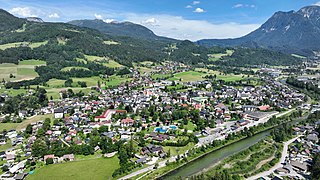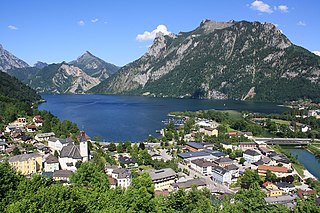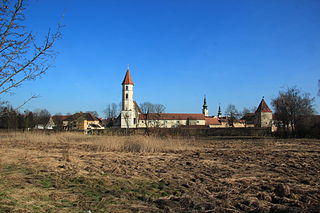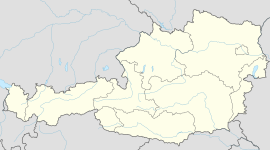
Mauthausen is a small market town in the Austrian state of Upper Austria. It is located at about 20 kilometres east of the city of Linz. The town lies on the banks of the Danube river, opposite the town of Enns, where the major Danube tributary of Enns joins it. During World War II, the town was the site of the Mauthausen concentration camp.

Bad Goisern am Hallstättersee is a market town in the Austrian state of Upper Austria in the district of Gmunden. It is part of the Salzkammergut resort area. At the 2005 census Bad Goisern am Hallstättersee had a population of 7,578 inhabitants.

Steyr is a statutory city, located in the Austrian federal state of Upper Austria. It is the administrative capital, though not part of Steyr-Land District. Steyr is Austria's 12th most populated town and the 3rd largest city in Upper Austria.

The market town of Bad Fischau-Brunn is an Austrian municipality in the district of Wiener Neustadt-Land in Lower Austria. It is situated some 50 km south of Vienna at the edge of Viennese Basin.

Bad Gastein (German pronunciation:[baːtɡasˈtaɪn] is a spa town in the St. Johann im Pongau District. Picturesquely situated in a high valley of the Hohe Tauern mountain range, it is known for the Gastein waterfall and a variety of grand hotel buildings.

Bad Ischl is a spa town in Austria. It lies in the southern part of Upper Austria, at the river Traun in the centre of the Salzkammergut region. The town consists of the Katastralgemeinden Ahorn, Bad Ischl, Haiden, Jainzen, Kaltenbach, Lauffen, Lindau, Pfandl, Perneck, Reiterndorf and Rettenbach. It is connected to the village of Strobl by the river Ischl, which drains from the Wolfgangsee, and to the Traunsee, into which the stream empties. It is home to the Kaiservilla, summer residence of Austro-Hungarian monarchs Emperor Franz Joseph I and Empress Elisabeth. In 2024, Bad Ischl will be one of the European Capitals of Culture – the third city in Austria after Graz (2003) and Linz (2009).

Bad Tatzmannsdorf is a municipality in Burgenland in the district of Oberwart in Austria.

Ebensee am Traunsee is a market town in the Traunviertel region of the Austrian state of Upper Austria, located within the Salzkammergut Mountains at the southern end of the Traunsee. The regional capital Linz lies approximately 90 km (56 mi) to the north, nearest towns are Gmunden and Bad Ischl. The municipality also comprises the Katastralgemeinden of Langwies, Oberlangbath, Rindbach, Kohlstatt and Roith.

Bad Radkersburg is a spa town in the southeast of the Austrian state of Styria, in the district of Südoststeiermark.

Steinbach am Attersee is a municipality of the Vöcklabruck district in the Austrian state of Upper Austria. It is situated in the Hausruckviertel region on the eastern banks of the Attersee, part of the Salzkammergut area.

Bad Vigaun is a municipality and spa town in the district of Hallein, in the Austrian state of Salzburg.

Bad Bleiberg is a market town in the district of Villach-Land, in Carinthia, Austria. Originally a mining area, especially for lead, Bad Bleiberg today due to its hot springs is a spa town.

Bad Sankt Leonhard im Lavanttal is a spa town in the district of Wolfsberg in the Austrian state of Carinthia.

Gallspach is a municipality and spa in the district of Grieskirchen in the Austrian state of Upper Austria. The center of the municipality is the market town Gallspach. It comprises also the following villages: Enzendorf, Gferedt, Niederndorf, Schützendorf, Thall, Thongraben, Vornwald and Wies.

Steinbach an der Steyr is a municipality in the district of Kirchdorf an der Krems in the Austrian state of Upper Austria.

Windischgarsten is a municipality in the district of Kirchdorf an der Krems in the Austrian state of Upper Austria. Since 1964, the town has been classified as a Luftkurort, a mountain spa town.

Neuhofen an der Krems is a municipality in the district Linz-Land in the Austrian state of Upper Austria.

Sierning is a municipality in the district of Steyr-Land in the Austrian state of Upper Austria.

Ternberg is a municipality in the district of Steyr-Land in the Austrian state of Upper Austria.

Ottensheim is a municipality in the district of Urfahr-Umgebung in the Austrian state of Upper Austria. At its rowing venue, Regattastrecke Ottensheim, it has hosted numerous international rowing competitions, including various World Championships, World U23 Championships, World Junior Championships, and World Cups.
























